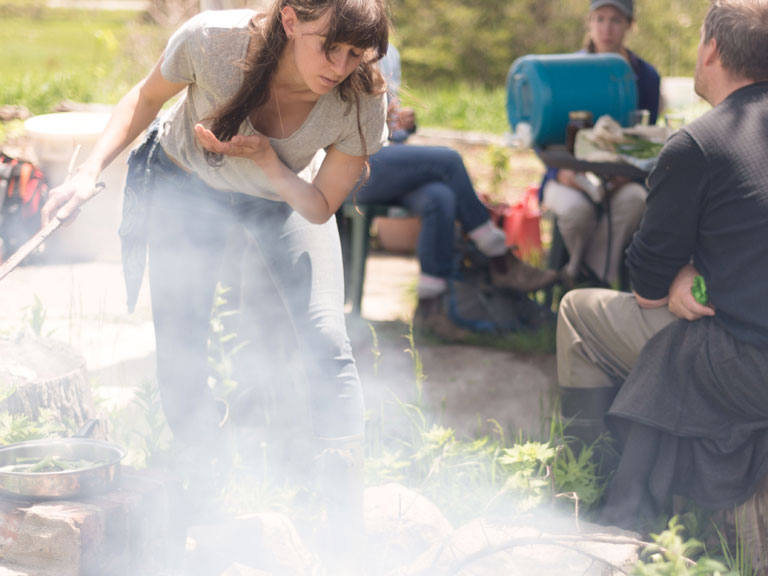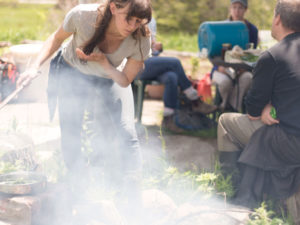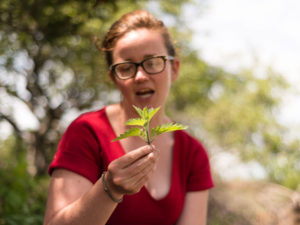County News
Wild world

How to turn outdoors into dinner
To an outsider, Hibernum Farms may appear a little unkempt, in need of some landscaping. But when owner Rebecca Lamb and her friend, Lee Earl look at the property, they see a lush landscape of wild foods, ripe for the picking.
Spend a morning wandering the tall grasses and wild weeds and you’d also be horrified at the thought of mowing this lawn.
Lamb and Earl both developed a curiosity for the earth’s bounty the way many do, by picking wild raspberries and other well-known edibles.

Rebecca Lamb stokes a fire upon which the group will cook wild asparagus and onions.
“I often ate blueberries and raspberries as a small child. Wild berries. And I was like, there must be a lot more to this,” says Earl, whose interest led her to study biology. “We got into identifying plants, and I heard some rumours about all the different things that you can forage… and I was like, oh, I really want to know this, but I’m nervous.”
Earl began to spend time with more experienced foragers, neighbours she’d spotted collecting wild plants and people who have made a business of working outdoors.
“It became clear to me that I learn better when I’m with people, and when they explain things to me and I can get the direct experience of doing it. That’s been a big benefit to me,” says Earl. “After a few years of doing that, [Rebecca and I] decided, ‘we don’t know anyone who’s doing this regularly. Maybe we are the people.’”
So the duo created the Wild Forager’s Society, a collective of people who are interested in learning more about the food that’s growing at their feet and all around them. For just over four years, they have been meeting on a monthly basis to wander in the wilderness and learn about the plants they came across.
They started in Toronto’s ravines. But when Lamb and her partner moved to the County and purchased the farm in Sophiasburgh, their experience had an opportunity to expand.

Lee Earl explains the uses of catnip, a member of the mint family.
On Sunday morning, Lamb and Earl met with a group of foragers on the farm to wander, to learn, and, as a bonus, to sample some wild onions and asparagus the two had foraged earlier in the week.
The curious group explored edible plants and discussed the basics, including some commonly found edible and medicinal plants like spruce tips, young milkweed, motherwort and catnip, along with tips on avoiding plants like poison ivy and using caution with wild parsnip.
Earl says the point is to bring people and plants together. But the ‘frolics’ are also free. For Lamb and Earl, it’s a reason to learn more about the wild world.
“Having a group that meets up on a regular basis, it pushes us to learn more and answer questions and get involved with folks,” says Earl.
One of her favourite plants is the abundant wild grape. Nearly every part is edible.
“On many occasions we’ve made dolmas—stuffed grape leaves, which is this cool rice dish,” she says. “The young tendrils that fork out like a snake tongue are delicious fresh, thrown into salad… and obviously, the grapes are amazing as well. I’ve had raw grapes, grape juice, grape jelly. Not yet enough bounty to have wine, but I dream.”
The Wild Forager’s Society meets every third Sunday of the month. The location of their outings can be found on their Facebook page.

Comments (0)